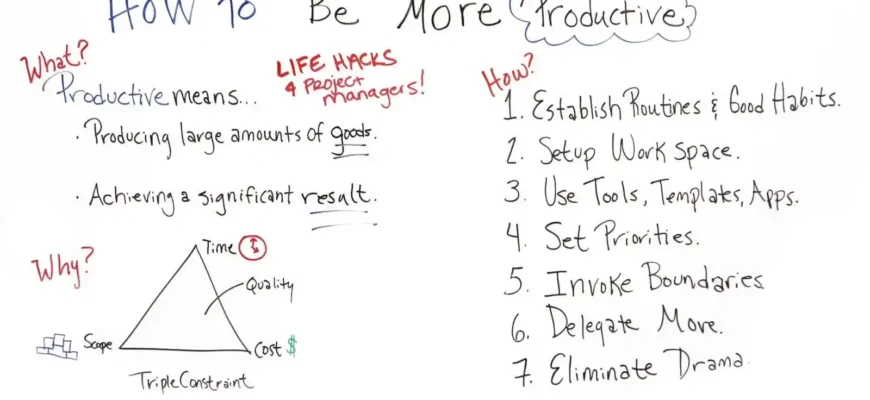Let’s face it, being productive at work isn’t always easy. Whether you’re working from home, at the office, or juggling multiple projects, productivity is an ongoing challenge. But you don’t have to go it alone. Drawing on decades of experience, backed by scientific research, this guide covers the many facets of productivity, including the best strategies, common pitfalls, and solutions that really work. It’s time to stop wasting time and start getting things done.
1. Understanding Productivity: It’s More Than Just Working Hard
Before we dive into strategies, let’s define what productivity really means. Productivity is often seen as doing more, faster, but that’s a simplistic view. According to the Harvard Business Review, true productivity is about achieving meaningful results—being effective, not just efficient.
- Research: A study by Gallup revealed that employees who feel engaged with their work are 21% more productive than those who are disengaged. So, motivation is key. Being busy doesn’t necessarily mean you’re being productive.
2. Optimize Your Environment
Did you know your physical environment can significantly impact your productivity? According to Cornell University studies, cluttered workspaces can reduce productivity by as much as 20%.
Action Steps:
- Declutter: A clean desk equals a clear mind. Try to maintain only what’s necessary for the task at hand.
- Lighting & Sound: Ensure adequate lighting—natural light is ideal, as University of Illinois research suggests it boosts both mood and productivity. If you can, minimize distractions like noisy colleagues or phone notifications. Noise-cancelling headphones could be a life-saver.
3. Prioritize Tasks Using the Eisenhower Matrix
We all know there’s always more to do than we have time for, but how can you sort through your tasks efficiently? This is where the Eisenhower Matrix comes in, a time-management method popularized by former U.S. President Dwight D. Eisenhower. It divides tasks into four quadrants:
- Urgent & Important: Do these first.
- Not Urgent but Important: Schedule these.
- Urgent but Not Important: Delegate.
- Not Urgent & Not Important: Consider dropping these.
Action Step: At the start of each day, review your to-do list and categorize tasks using this framework. Studies from Carnegie Mellon University show that prioritization leads to less stress and better task completion.
4. Focus with the Pomodoro Technique

We’ve all been there—staring at the screen for hours, accomplishing little. The Pomodoro Technique, developed by Francesco Cirillo, suggests breaking work into 25-minute chunks (called Pomodoros) with short breaks in between. It’s simple but incredibly effective.
- Scientific Backing: Research published in Neuropsychologia supports this, showing that short bursts of focused work followed by rest can increase productivity and reduce mental fatigue.
Action Step: Try setting a timer for 25 minutes, followed by a 5-minute break. After four Pomodoros, take a longer break. You’ll be surprised by how much more you accomplish.
5. Mastering the Art of Saying “No”
Let’s get one thing straight: you can’t do it all. And no matter how much you want to help others, taking on too many tasks will only decrease your productivity. According to Harvard Business School, saying “no” effectively is a skill that high achievers often use to maintain focus.
Action Step: Learn to politely say “no” or delegate tasks when necessary. It’s a game-changer, both for you and your team.
6. Avoid Multitasking—Focus on One Task at a Time
Multitasking is a productivity killer. Despite what we often hear, the American Psychological Association has shown that multitasking can reduce productivity by up to 40%. Why? Because our brains aren’t designed to focus on multiple tasks simultaneously. The constant switching between tasks creates inefficiencies and leads to mistakes.
Action Step: Use the “single-task” method. Focus on one task, finish it, then move on to the next.
7. Utilize Technology, But Wisely
Technology can be a huge productivity booster, but only if used strategically. Apps like Trello, Asana, and Notion are excellent for task management. However, constant notifications from your phone or emails can be a huge distraction. According to Pew Research Center, one of the biggest culprits of low productivity today is the constant bombardment of notifications.
Action Step: Use technology to automate and organize, but set clear boundaries. Turn off non-urgent notifications and set specific times for checking emails.
8. Take Care of Your Body and Mind
You can’t expect to perform well if you’re not taking care of yourself. Studies from Mayo Clinic show that exercise can enhance brain function, improve mood, and increase productivity. Getting adequate sleep (7-9 hours per night) is equally important. Mental fatigue is real, and poor sleep can lower cognitive performance.
Action Step: Incorporate regular physical activity into your routine—whether it’s walking, yoga, or a full workout. And don’t skimp on sleep—your brain needs it to function at its best.
9. Leverage the Power of Routines

Routines are the unsung heroes of productivity. According to The American Journal of Lifestyle Medicine, establishing a morning routine can lead to more effective work habits throughout the day. This is because it sets the tone and primes your brain for success.
Action Step: Design a morning routine that works for you. It could be a combination of exercise, planning your day, or even meditation. Whatever helps you start your day with focus.
10. Take Breaks—It’s Not a Waste of Time
It may sound counterintuitive, but breaks are an essential part of the productivity puzzle. Research from Stanford University indicates that taking breaks throughout the day can help improve focus and reduce burnout.
Action Step: Take regular breaks, whether it’s stepping outside for fresh air, doing a quick stretch, or practicing mindfulness. Your brain will thank you later.
11. Track Your Progress and Adjust
Finally, don’t forget to track your progress. Productivity isn’t static—it evolves. Regularly evaluating your productivity strategies will help you identify areas for improvement. Psychology Today notes that reflection leads to better long-term performance by helping you adjust and improve your methods.
Action Step: At the end of each week, review your goals and assess how well you’ve met them. Make adjustments as needed.
What People Are Saying About Productivity
- Sarah, 32, Marketing Executive, USA:
“The Eisenhower Matrix has really helped me prioritize. I’ve learned to say ‘no’ more often, which has reduced my stress levels significantly.” - Carlos, 45, Software Developer, Spain:
“I used to think multitasking was the key to getting more done, but now I single-task and take Pomodoro breaks. It’s been a game-changer.” - Ayesha, 28, Teacher, India:
“Taking breaks used to feel like procrastination. Now I know better! Short breaks have actually made me feel more energized and productive.” - David, 60, Consultant, UK:
“I never realized how much my workspace was impacting my productivity. A tidier desk has definitely improved my focus.” - Rita, 39, Project Manager, Nigeria:
“Having a morning routine has transformed my entire day. I feel more in control and less rushed.”
Conclusion
Productivity isn’t just about working harder; it’s about working smarter. From setting priorities and focusing on one task at a time, to leveraging technology and taking care of your physical and mental health, the road to becoming more productive is paved with simple yet effective strategies. Keep experimenting, find what works for you, and don’t forget to take breaks! After all, we’re in this for the long haul.









